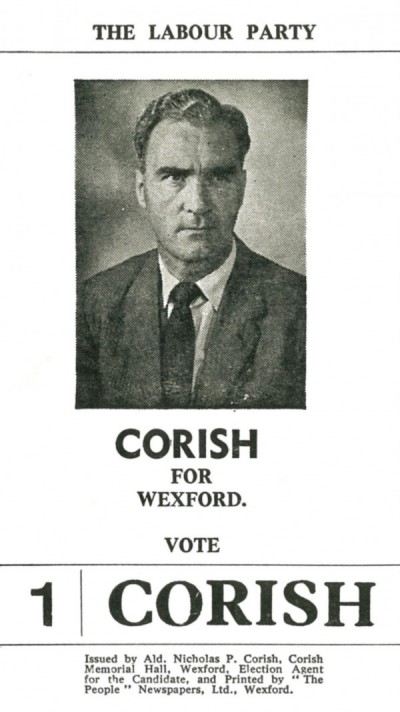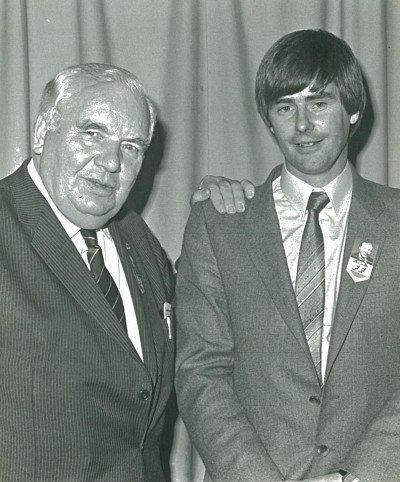Fighting for a share, not the crumbs
By Tom Mooney
Traditionally, the constituency of Wexford, in the electorate’s choice and in the selection of candidates, has played a conservative hand for the majority of General Elections.
Until 2011, when Mick Wallace became the first Independent to top the poll, the spoils were shared between Fianna Fail, Fine Gael and Labour. So, no surprises there, you might surmise: prior to 2011 the choice on offer by the major parties was rarely a mix of the new and the familiar, just the usual suspects.
Leaving aside internecine squabbles over the carve-up of the constituency on the hustings, the candidates dished up for the most of the 1980’s and 1990’s were the tried and the tested.
The hegemonic control for twenty years of the body politic in Wexford by Ivan Yates, Avril Doyle and Michael D’Arcy Snr (Fine Gael), Hugh Byrne and John Browne (Fianna Fail) and Brendan Howlin (Labour) was shattered – briefly – by the election of Liam Twomey in 2002.
It is overlooked that when Twomey disrupted the consensus in Wexford, he ran as both an Independent (with no prior electoral experience) and as a blow-in, but nabbed a seat. Finding life in the backbenches too isolating as an Independent, he was successfully wooed by Fine Gael in time for the 2007 election: he was not forgiven for what was viewed as a betrayal by his party-averse supporters, and duly placed on life support in the Seanad for five years.
Ah, the A&E of the Seanad, always viewed as an acceptable limbo by Wexford politicians whose ambition was stifled by the electorate: Avril Doyle, Michael D’Arcy (father and son), Hugh Byrne, Brendan Howlin and Twomey, have all been incarcerated there.
With the wholesale retirements of the class of 82-02, their surnames have not gone away: running in 2016 are Aoife Byrne (daughter of Hugh), James Browne (son of John) and Michael D’Arcy (son of Michael).
Both D’Arcy and Browne are continuing a family tradition which stretches back to World War II.
Michael D’Arcy (Senior) was co-opted to Wexford Co. Council on the death of his father Timothy in 1958, while outgoing TD John Browne succeeded his uncle Sean Browne in 1982, who was first elected to the Co. Council in 1945, and to the Dail in 1957.

Ivan Yates takes a break from the hustings in The Curracloe Tavern with Tommy Neville and John Hanrahan.
When Ivan Yates broke the mould by becoming the youngest deputy in the 23rd Dail in 1981, he had no meaningful political background: he was elected alongside veteran Lorcan Allen, who had succeeded his late dad Denis in 1961, holding onto a Fianna Fail seat first won by his father as far back as 1927, a handful of years after the foundation of the State.
Avril Doyle (Wexford’s first female Mayor) came onto the scene in the November election in 1982, and Fine Gael achieved the miracle of three seats in Wexford (first achieved by Fianna Fail in 1957): her Belton background screamed three uncles, father and grandfather, who were all active in politics.

Another election, another campaign: Brendan Howlin is flanked by his director for elections, Ted Howlin, and Labour supporters Marian Doyle and Mary Fallon.
Brendan Howlin, whose father John was a director of elections for Brendan Corish, has nobody but himself to thank for his career: at a time of bitter polarity in the Labour Party in the early years of Dick Spring’s leadership, Howlin – after Spring nominated him to the Seanad – nailed his colours to the Kerry man’s mast, and prospered.
Occasionally, there have been attempts to buck the party trend: Seamus Cullimore, Sean Connick and Tony Dempsey were all elected for Fianna Fail to the Dail for a single term; the election of Fine Gael’s Paul Kehoe in 2002 and Michael D’Arcy Jnr in 2007 finally consigned to memory the dominance of Ivan Yates in Enniscorthy and the rivalry – not always sporting – between the Doyle and D’Arcy Snr camps, which dated back to what might seem an injudicious decision by Garret Fitzgerald as Taoiseach (1982-87), to strip one of a Junior Ministry, and give it to the other. Political folklore, but we loved the spats back then: Doyle v D’Arcy, Cullimore v Byrne, Byrne v Denis Aspel. The odd time a new head would appear over the parapet – John Dwyer, Lisa McDonald, Colm O’Gorman – only to be blown away by Wexford conservatism. And amidst all this fighting and skulduggery, Brendan Howlin ploughed a lone furrow. There was the suspicion of a gunpowder plot when Helen Corish flexed the family muscle in 1991, but some Roundup did the trick, and Labour has been a one rose patch ever since.
Howlin has shown no inclination toward retirement and as such Labour hasn’t invested in an adequate seat assurance policy in the unlikely scenario that one of the most effective Ministers in the current administration, decides to call time.
When we think of the election in 2011, there was a sea change. The economy had collapsed, the outgoing government was as imbecilic as the last days of the one thousand year Reich, and the electorate wanted its pound of flesh. Onto this populist bandwagon, like Jean Valijean from Les Miserables, appeared Mick Wallace, who unambiguously and emphatically said he wasn’t there to fill potholes or repair local authority windows, and duly topped the poll.
A century hence, I think people will view the 2011 election as truly revolutionary (Fianna Fail lost more than half of its first preference vote from 2007 while Fine Gael returned a record 76 seats), and the tremors today are still palpable: unprecedented new faces in the Wexford constituency for Friday’s poll, of every persuasion, emboldened by the success of independent candidates like Ger Carty in local elections. And yet, when the dust has cleared, it will be no surprise if the three biggest parties nab four out of five seats.
As an aside, in his Paddy Power blog, Ivan Yates reckons that Fianna Fail could get two seats here with only Paul Kehoe elected for Fine Gael. In the battle of North Wexford, Yates feels Malcolm Byrne could edge out D’Arcy, which would be a loss of a FG seat on the back of Twomey’s retirement.
Perhaps not: nobody in their right mind predicted Wallace’s first preference vote of 13,329, not even the forecasting-extraordinaire soothsayers of the Strawberry Festival. A colourful character, not without controversy, it remains to be seen if his love-in with Wexford apes Michael Lowry and Tipperary North.
The history of this constituency was once, ironically, a slave to change. A five seater in 1923, it received a sliver of Carlow in 1935, but with no increase in representation. In 1947, two years after Brendan Corish was first elected to the Dail, the constituency was made conterminous with the county boundary.
In 1961, the Bunclody district was included in Carlow-Kilkenny and Wexford reduced to four seats, but in 1980 Wexford reverted to a five seater. At this juncture it is opportune to remember the Esmonde family and North Wexford: a series of Esmondes, bookended by Sir Thomas, as far back as 1841, and John Grattan until 1977, held seats in both Westminster and the Dail, including Sir Thomas H. Esmonde (founder of this newspaper in 1902 with William Sears) Sir Osmond Grattan Esmonde (1933), Sir John Lymbrick Esmonde (1937) and Sir Anthony Charles Esmonde (1951).
No constituency in the country has been gifted with so many knights. Alongside the distinguished family names of Browne, D’Arcy, Allen and Esmonde, there is the monolithic Corish, beginning with Richard, stalwart of the 1911 lock out, 1916 Rising deportee, member of the 1921 Dail, 25 times Mayor of Wexford, and succeeded as a T.D. in 1945 by Brendan, first Labour Party Tanaiste who held onto the seat until 1981. A reluctant Des Corish ran in the February 1982 election, but an increase of 0.4% in the share of the vote saw Fianna Fail claim three seats: Sean Browne, Lorcan Allen and Hugh Byrne.
Within less than a year, the political landscape had changed once more. Fianna Fail and Fine Gael squabbled over the carcass of a Labour Party in transition: against the odds, newcomer Brendan Howlin enhanced his party’s standing, so his battle with Avril Doyle for the last seat depended on who was in front when one or the other came to be eliminated.
After Gus Byrne bit the dust and 670 of his votes leaked to his fellow Wexford town candidates, Doyle was just 337 votes ahead of Howlin, but it was enough, and joined Yates and D’Arcy, improving Fine Gael’s share of the vote – in just eight months – from 37.7% to 41.4%.
34 years later, Howlin is the last one standing from the class of 82. His enhancement as a candidate of substance was underscored with his achievement in the 1989 election by increasing the Labour vote substantially with over a quota of first preferences, thereby topping the poll, ahead of more seasoned campaigners Yates, Browne and D’Arcy.
But, the more things change, the more they stay the same. Looking at press clippings from the 89 campaign, I happened upon this quote by Ivan Yates: “The issues in the campaign were unemployment and emigration, the deterioration of the health service, cutbacks in public service such as education, the high rates of personal taxation and the issue of integrity in government.”


